Fall 2025 Newsletter
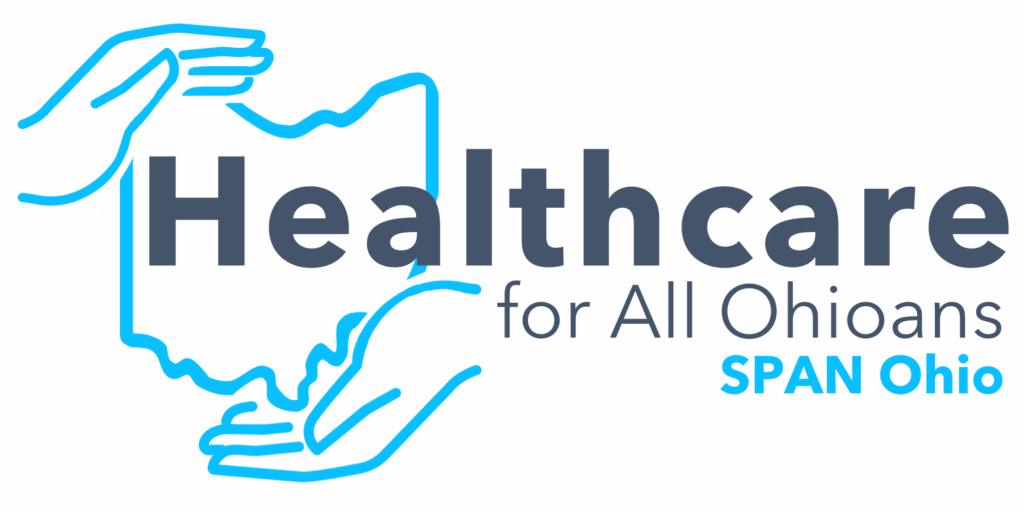
Table of Contents
Director’s Report
Regional Reports
Committee Reports
Recommended Reading
- Medicare Will Require Prior Approval for Certain Procedures — A new program called the Wasteful and Inappropriate Service Reduction (WISeR) Model, ostensibly aims to reduce “fraud, waste, and abuse in Medicare fee-for-service via the implementation of technology-enabled prior authorization processes for select states.” (including Ohio — see below)
- Huge numbers of Ohioans to see big increases in insurance costs
- Money Can’t Buy Life: The Richest Americans Die Earlier Than the Poorest Europeans
- Medicaid cuts will hurt all Ohioans, economists say
- ‘Gouging’: US Health Insurance Giants Raked in Over $71 Billion in Profits Last Year
- I’ve Spent My Life Fighting for Kids’ Health, and I Won’t Stop Now
- What To Make of the $50 Billion Rural Hospital Grants Program
- GOP Congressman Cashed Out Hospital Investments Before Voting for Biggest Medicaid Cut in History
- The Answer to Medicaid Cuts Should Be Medicare For All
- New Senate Report Details How Private Equity ‘Devastates’ Hospital Systems
October 24, Friday, 6:00 PM
Zoom Movie Showing,
American Hospitals: Healing a Broken System.
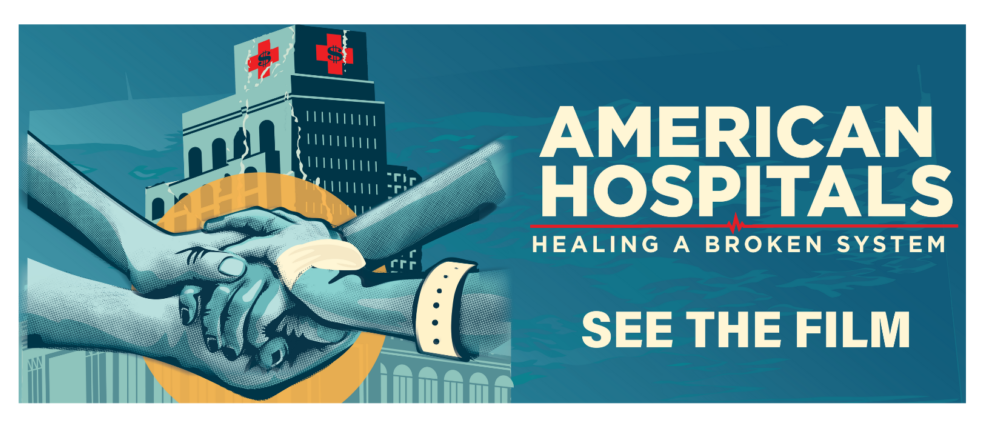
American Hospitals takes a deep dive into the out-of-control cost of hospitals and their transformation into a money-driven big business. How can we incentivize hospitals to provide the highest quality care with the lowest affordable cost to the community?
To see the trailer, go to
AMERICAN HOSPITALS: Healing a Broken System | Official Trailer
To register for the movie go to:
Register for American Hospitals Movie, Oct 24
Note: This is a one-time showing. There will be no rebroadcast.
Director’s Report
As this fall weather surrounds us, we are talking with other organizations about different events. Indivisible and the Ohio Young Dems are a couple.
The thought at the present time is that our bills in Columbus will not progress until the legislature has changed. We are looking into participating with organizations to stop the Gerrymandering. More information will be forthcoming.
We have changed from PayPal on our web page to Act Blue. Peter Thiel is a billionaire and owns PayPal. Needless to say he works against us. Act Blue’s Charitable organization has already sent us approximately $500.00 to Healthcare for All Ohio, our 501 c3.
We had talked about doing a ballot initiative, but that has been tabled for the present time. It takes a LOT of money and time to do that, and we aren’t prepared for that, presently
Our three-to-five-year Strategy Plan has been completed and will be introduced to all in due course.
We need Regional Coordinators, Marketing leaders, and a treasurer. Contact me if interested or have a lead of someone interested.
Kendall Mays
Ohio State Director
Regional Reports
| Regional Coordinators, with their contact information, are shown below. Please contact the Coordinator for your region to attend events, get active, or join Heathcare for All Ohioans/SPAN Ohio (HCFAO/SPAN). Regional Coordinators are currently needed in Region 2 [Toledo and Northwest Ohio] & Region 6 [Akron, Canton, and East Central Ohio]. If you would consider filling an open position, please contact span@spanohio.org. |
Region 1 (Cleveland, Northeast Ohio)
Coordinator: Cathe Caraway (310-749-6111) cathe@carawaylaw.com
Region 1 held a fun-filled Medicare 60th Birthday Celebration and Fundraiser in July. Featured speakers were Representative Tristan Rader and former State Representative Mike Skindell, Politico Podcaster Juan Collado Diaz, along with Regional Coordinator Cathe Caraway, moderated the legislators’ discussion of HB 289, Establish Ohio Health Care Plan for Universal Health Coverage, and related health legislative trends. A video of the panel discussion can be found at: https://www.youtube.com/live/2JgLP-8cfgg?si=3flFBYYuCdgd3WqV.
 Speakers State Representative Tristan Rader and Former State Rep Mike Skindell, flanked by moderators Cathe Caraway and Juan Collado Diaz
Speakers State Representative Tristan Rader and Former State Rep Mike Skindell, flanked by moderators Cathe Caraway and Juan Collado Diaz
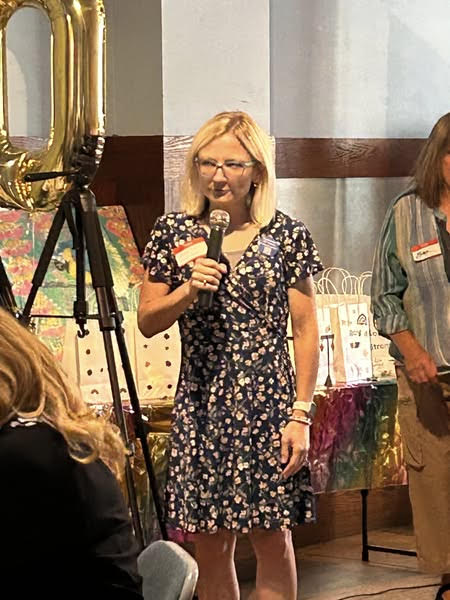
Special guest, Dr. Lauren Beene– a University Hospital pediatrician who was fired in June for organizing a union at the hospital–also spoke. Cleveland.com printed several articles about the punitive action taken against Dr. Lauren Beene and Dr. Valerie Fouts-Fowler. Because silencing doctors, silences patients, Region 1 members have taken part in multiple demonstrations calling for the reinstatement of Dr. Lauren Beene and Dr. Valerie Fouts-Fowler. See below.
Our Medicare 60th birthday bash was held at minority, woman-owned restaurant, Chef Carolyn’s Exotic Cuisine, in a diverse community on the west side of Cleveland (https://maps.app.goo.gl/LkzsvEn17GZVZ5Pc6). A delicious Jamaican dinner buffet included ethnic and vegetarian options. Entertainment included recitations by poet Raja Belle Freeman, and a short sing-a-long led by Marlene Goldheimer and Brian Houlehan. The night ended with dancing and karaoke, with DJ Eddie spinning the discs. Ticket sells, donations, and a silent auction raised almost $3,000.
Here is an article from Cleveland.com about the two doctors:
University Hospitals physicians claim retaliation for union organizing efforts
CLEVELAND, Ohio — University Hospitals [UH] has taken punitive action against two pediatricians who were leading a push to organize UH physicians into a union, according to a news release from a group of organizing physicians.
The group, called Concerned UH Physicians, is led by the two doctors the group said were punished by UH, Dr. Lauren Beene and Dr. Valerie Fouts-Fowler. . . .
For more of the article, see:
Cleveland.com – Physicians claim Retaliation for Union Organizing
Take action here to reinstate Dr. Laura Beene and Dr. Valerie Fouts-Fowler!
Among the Doctors’ support rallies we participated in was a July 30 rally at University Hospitals. The picture below shows State Senator Kent Smith speaking.

Other speakers at the July 30th rally included former Ohio State Senator Nina Turner, pediatric patient Reese Klubert, and TikTok influencer “Nurse Blake.”
Additionally, Region 1 members staffed two tabling events: the Lakewood Summer Meltdown (7/19/2025) and the Tremont Arts and Crafts Festival (9/20/2025-9/21/2025). As a result of Anne Caruso updating our spinning game materials, conversations blossomed as we asked kids health-promoting questions and presented short insurance scenarios to adults. Compared to past years, festival attendees (a) expressed greater concern about healthcare funding, (b) discussed declines in the quality of care received, and (c) are experiencing more problems with insurance providers. The distribution of materials, collection of email sign-ups, and invitation to future activities were the focus of our tabling events.
 Linda, Lou, and Anne
Linda, Lou, and Anne
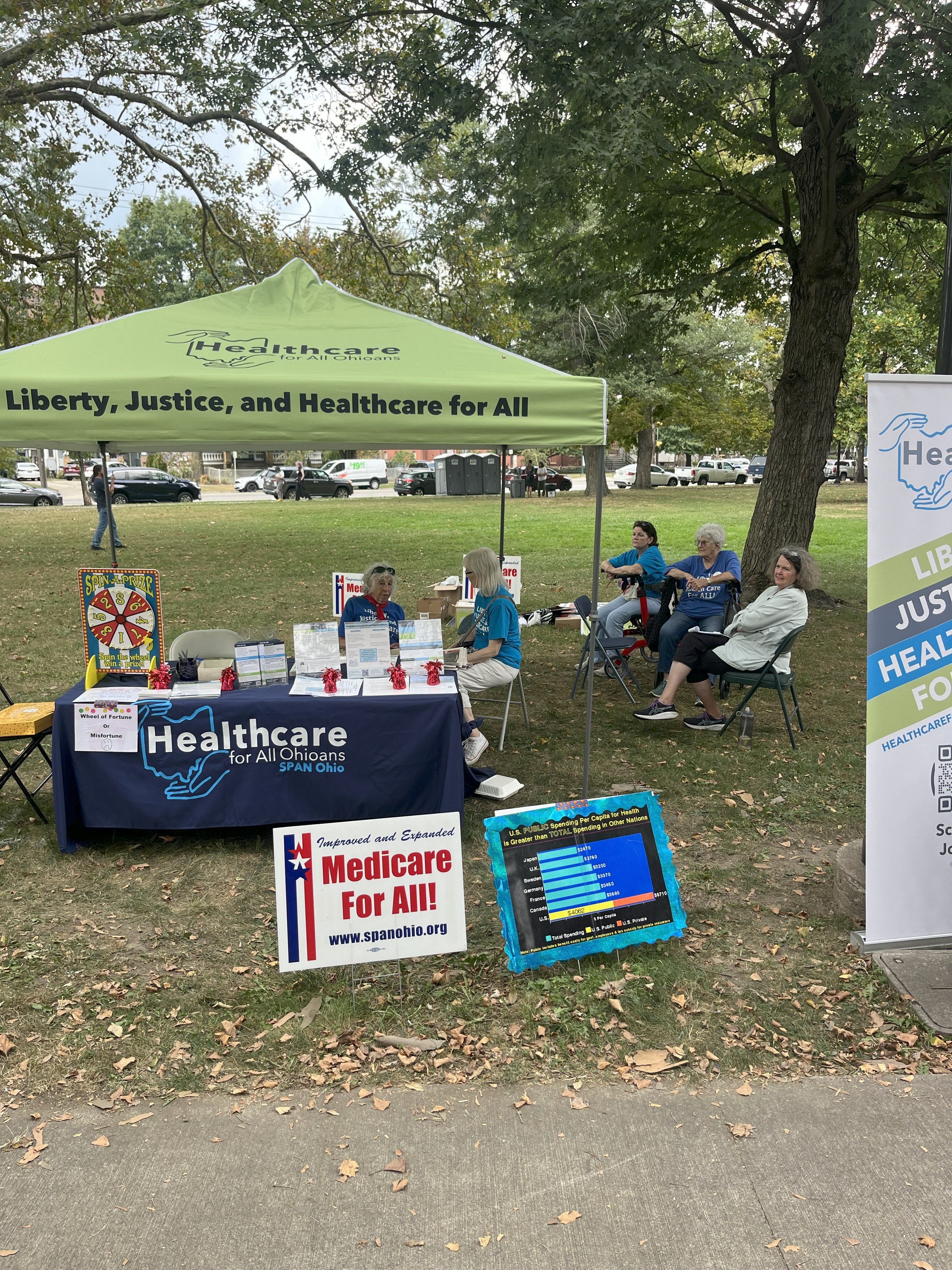
Upcoming events in the Cleveland area directly:
- October 5, Sunday, 3:00 PM Cleveland SPAN/HCFAO meeting hosted on the west side of Cleveland.
- November 14, Friday, 3:30 Health Book Club – Location tentative (west side of Cleveland).
- December 6, Saturday Holiday Party.
To get details of these events, please contact ClevelandSpan@spanohio.org.
Region 4 (Cincinnati, Southwest Ohio)
Coordinator: Deliah (Dee) Chavez (513-413-1178) dee49@fuse.net & Chot VanAusdall (he/him) (513-617-5129)vanausdall@fuse.net
Active members of Region 4 have done lots of tabling over the summer, reaching out to diverse groups in Cincinnati, Lebanon, Hamilton and New Richmond. This has been a successful vehicle to educate, recruit and mobilize.
Many of our members are working closely with the Cincinnati chapter of PNHP (Physicians for a National Health Program), some serving on its Steering Committee and the National Political Advocacy Committee. We are collaborating with other groups, including the local ODP (Ohio Democratic Party) Veterans Caucus, PDA (Progressive Democrats of America) Ohio, Young Dems, One Payer States, and National Single Payer.
Region 5 (Columbus, Central Ohio)
Coordinator: Kurt Bateman (614-562-1066) kurt.pdamerica@gmail.com
Health Care For All Ohioans Region 5 started and ended the summer by collaborating with outside organizations.
On June 19th members of HCFAO marched in the Makinde Foundation sponsored parade to celebrate Juneteenth. Additionally, HCFAO received the “Ally Recognition Award” from the organization.
Later in June Region 5 participated in the Columbus Community Festival (Comfest) by making a presentation at the Peace and Healing Pavilion at Goodale Park. We occupied a booth at Comfest for all three days, as we did in 2024. Watch for future volunteer opportunities to help next year.
As the summer waned, members joined in candidate forums in Gahanna Ohio and elsewhere because keeping abreast of political activity is essential to achieving our goals.
In a demonstration of support for fair voting districts, some Region 5 members of HCFAO joined The ACLU, LWV (League of Women Voters), and Fair Districts Ohio. The Ohio General Assembly is preparing to redistrict the federal representative districts across Ohio. Passage of healthcare legislation requires knowledge of the redistricting efforts and outcomes.
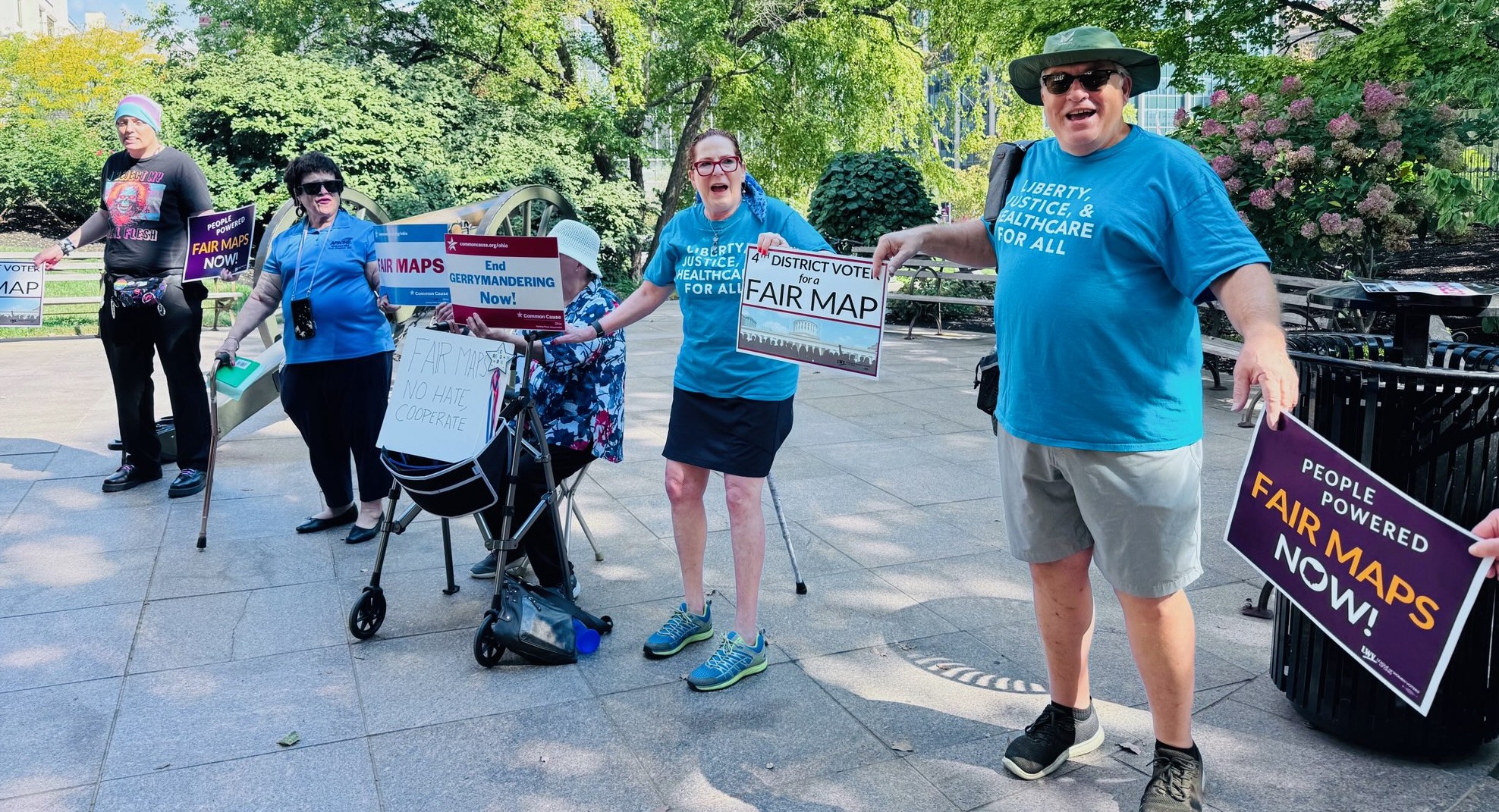

The Ohio Supreme Court found serious faults in the original process, making it necessary to redraw district lines again in the middle of the decade.

Region 5 HCFAO members and friends: Watch for notice of our fall zoom call to discuss this and other information regarding our recently completed strategic plan in the coming weeks.
Region 7 (Dayton, West Central Ohio)
Coordinators: Matthew Noordsij-Jones, (937-321-8698), mattnj78@gmail.com.
Bill Davis, (937-264-0377), wndavis2@gmail.com
Coordinator Bill Davis spoke at the September meeting of the Darke County Democrats in Greenville. His presentation and Q&A time was well received with people taking signs & literature.
Committee Reports
Equity Committee Report
The Equity Committee’s most recent workshop, Medicaid and Disabilities, was held on June 26, 2025. A recording of the workshop is available on the HCFAO YouTube channel. Two more workshops are planned for 2025. The first, Round-table Discussion on Building Coalitions, will be held on Thursday, October 2nd, and the second, Barriers to Health Care for Native Americans, will be held on Thursday, November 13th.
Having received approval from the Executive Committee, we are ready to send out the demographic survey created by our committee. The survey will be sent out to the entire database as a first step in tracking and expanding the diversity of our membership.
The Equity Committee continues to send out a monthly email newsletter with news and updates relevant to current health equity concerns. We encourage all regional coordinators to watch for opportunities to participate in events sponsored by diverse communities, particularly traditionally marginalized communities, in their areas!
—Nancy McCrickard, Chair
Lobby Committee Report
The Lobby Committee is resuming our outreach to state representatives and senators after a summer pause.
We will target those on the House Insurance Committee and the Senate Financial Institutions, Insurance and Technology Committee where HB289 and SB78, Establish the Ohio Health Care Plan were assigned.
After much discussion we will also focus on ideas for incremental plans to improve health care access in Ohio.
Members have spoken to 2 key legislator supporters, Michele Grim, District 43 and Karen Brownlee, District 28 who have expressed interest and/or are moving ahead.
Our next Lobby Comm. mtg. is scheduled for Wed., Nov. 19th at 7 PM. If you are interested, contact Dee.
Dee Chavez, Chair (513-413-1178) dee49@fuse.net
Recommended Reading
So called “WISeR*” model:
Medicare Will Require Prior Approval for Certain Procedures
A pilot program in six states [Including Ohio] will use a tactic employed by private insurers that has been heavily criticized for delaying and denying medical care.
By Reed Abelson and Teddy Rosenbluth – August 28, 2025
Like millions of older adults, Frances L. Ayres faced a choice when picking health insurance: Pay more for traditional Medicare, or opt for a plan offered by a private insurer and risk drawn-out fights over coverage.
Private insurers often require a cumbersome review process that frequently results in the denial or delay of essential treatments that are readily covered by traditional Medicare. This practice, known as prior authorization, has drawn public scrutiny, which intensified after the murder of a UnitedHealthcare executive last December.
Ms. Ayres, a 74-year-old retired accounting professor, said she wanted to avoid the hassle that has been associated with such practices under Medicare Advantage, which are private plans financed by the U.S. government. Now, she is concerned she will face those denials anyway.
The Centers for Medicare and Medicaid Services plans to begin a pilot program that would involve a similar review process for traditional Medicare, the federal insurance program for people 65 and older as well as for many younger people with disabilities. The pilot would start in six states next year, including Oklahoma, where Ms. Ayres lives [& Ohio].
The federal government plans to hire private companies to use artificial intelligence to determine whether patients would be covered for some procedures, like certain spine surgeries or steroid injections. Similar algorithms used by insurers have been the subject of several high-profile lawsuits, which have asserted that the technology allowed the companies to swiftly deny large batches of claims and cut patients off from care in rehabilitation facilities.
The A.I. companies selected to oversee the program would have a strong financial incentive to deny claims. Medicare plans to pay them a share of the savings generated from rejections.
See full article in: N Y Times – Medicare Will Require Prior Approval for Certain Procedures
Also see a related article from the Cleveland Plain Dealer at:
Your doctor says you need pain treatment, but Medicare’s AI might disagree
*WISeR stands for Wasteful and Inappropriate Service Reduction
If you are interested in opposing this change to traditional Medicare, which would be the first step in requiring pre-authorization, please contact HCFAO (Healthcare for all Ohioans) at spanohio.org
Huge numbers of Ohioans to see big increases in insurance costs
Hikes could put health insurance out of reach for many
By Marty Schladen – August 18, 2025
Experts are warning that more than 500,000 Ohioans are poised to lose insurance subsidies starting next year. In many cases, the increased costs they’ll face will be so big that more than 100,000 will lose their coverage, they warn.
. . .
The subsidy is known as the “enhanced premium tax credit.” . . .
It’s available to people making between 100% and 400% of federal poverty guidelines. For a family of three, that’s between $26,650 and $106,600 a year. Nearly 20 million Americans and 530,000 Ohioans receive it.
More than 90% of those who get insurance through the Affordable Care Act marketplace receive the subsidies, and they’re set to expire at the end of the year.
The average recipient saves about $700 a year because of them, the Center for American Progress reported. But some save much more, meaning they have a lot more to lose.
“A typical 60-year-old couple making $82,000 … would see monthly marketplace premiums more than triple, from $581 to $2,111 — an annual increase of roughly $18,400,” the group reported late last year.
See full article in: Ohio Capital Journal — Ohioans to see Big Increases in Insurance Costs
Money Can’t Buy Life: The Richest Americans Die Earlier Than the Poorest Europeans
By Luis Prada – April 17, 2025
. . . .
Most Europeans aren’t delaying doctor visits because they can’t afford them. This is allowing them to leave longer, healthier, happier lives. The study sliced people into four wealth brackets and compared mortality rates. Across the board, Americans died more.
In fact, the poorest Europeans in places like Germany, France, and the Netherlands had lower death rates than the richest Americans. . . . .
See full article in: Vice — Money Can’t Buy Life
Medicaid cuts will hurt all Ohioans, economists say
By: Marty Schladen – August 7, 2025
. . . .
Medicaid recipients and their advocates say that the savings won’t be from people going to work and making enough money that they no longer need Medicaid. Instead, they say, the requirements will create additional red tape that forces the needy off of the system.
Ohio emergency room docs say that by law they have to care for anybody with a medical emergency. KFF estimates that the law Trump signed will create 440,000 more uninsured Ohioans.
Those people aren’t going to stop getting sick and injured, and hospitals will have to pay to care for those who show up in their emergency rooms. ER docs say the increase in uncompensated care will affect everybody in the form of longer waits to be seen, longer times “boarding” in the ER waiting for a bed in the appropriate department, and staff cuts across the hospital.
Each of those things has been linked to worse patient outcomes and increased mortality.
See full article in: Ohio Capital Journal — Medicaid Cuts Will Hurt All Ohioans
‘Gouging’: US Health Insurance Giants Raked in Over $71 Billion in Profits Last Year
Meanwhile, 17% of Americans say they’re using buy now, pay later services for medical or dental care.
By Jessica Corbett – August 6, 2025
The seven largest publicly traded U.S. health insurance companies made a collective $71.3 billion in profits last year, and their CEOs took home a total of $146.1 million in compensation, according to an analysis released Wednesday by an ex-industry executive. . . . .
See full article in: Common Dreams: Health Insurance Raked in Billions
I’ve Spent My Life Fighting for Kids’ Health, and I Won’t Stop Now
By Annie Andrews, MD, MS, pediatrician running for the US Senate from South Carolina – July 24, 2025
On July 4, President Donald Trump signed the One Big Beautiful Bill Act into law, slashing nearly $1 trillion from Medicaid over the next decade. As a pediatrician, I can tell you this isn’t just a policy decision, it’s a direct attack on the health of our children.
Medicaid is the backbone of our healthcare system — especially for kids. It’s the largest insurer of children in America, covering 40% of all births and millions of routine doctor visits, hospital stays, and therapies. . . .
After working nearly two decades in children’s hospitals as a pediatrician, I have seen firsthand how critical this program is and how devastating these cuts will be. Gutting the Medicaid program is not just a healthcare problem. It is a moral and political crisis.
Healthcare shouldn’t be political — but in America, it is. And because of that, children’s lives are on the line. Budgets reflect values — and right now, too many politicians don’t value our most vulnerable. The One Big Beautiful Bill Act has made that abundantly clear.
More Than a Number
Cutting almost $1 trillion from Medicaid nationwide . . . will be devastating to our healthcare system. It means that up to 20 million Americans stand to lose access to Medicaid. It means that rural hospitals will hire fewer nurses, respiratory therapists, and doctors, and some will be forced to close. It means even more crowded emergency departments and delays in life-saving surgeries.
It also drives up costs for everyone. When kids can’t get preventive care through Medicaid, they end up in emergency departments with avoidable crises — costing families more, overwhelming hospitals, and putting a strain on the entire healthcare system. These cuts don’t save money. They just shift the burden onto vulnerable patients, parents, providers, and communities that are already stretched too thin.
See full article in: Med Page Today — Fighting for Kids Health
What To Make of the $50 Billion Rural Hospital Grants Program
By Drew Altman – July 18, 2025
. . . the $50 billion rural hospital fund . . . was included in the tax and budget bill to soften the blow of the Medicaid cuts and provide political cover so that key Republican senators who were concerned about the cuts could vote for it. This time, the struggling hospitals are rural hospitals with clout, particularly with Republicans. These hospitals too have legitimate needs. But there are similar questions about how the grant program may mix purpose and politics. We recently put out a brief describing how it works (A Closer Look at the $50 Billion Rural Health Fund in the New Reconciliation Law ). Here are a few of the things to watch for as it unfolds.
Will the fund really help the hospitals absorb the Medicaid cuts or will it mostly play out as political favoritism and pork? There are 1,800 rural hospitals in the country and almost half operate with negative margins in rural areas that stand to lose $155 billion in Medicaid funding over the next 10 years under the law.
. . . Nothing in the legislation directs the funds to hospitals with a disproportionate share of Medicaid beneficiaries or the uninsured.
. . . . Yet, with most of the money distributed [starting next year] before the bulk of the Medicaid cuts hit and the uninsured population swells [starting 2027], it doesn’t seem destined to cushion much of the blow from the Medicaid cuts, which was its intended purpose.
See full article in: KFF – What to Make of the $50 Billion Rural Hospital Grants Program
GOP Congressman Cashed Out Hospital Investments Before Voting for Biggest Medicaid Cut in History
“Congressman Bresnahan didn’t just vote to gut Pennsylvania hospitals. He looked out for his own bottom line before doing it,” said one advocate.
By Julia Conley – August 18, 2025
Congressman Rob Bresnahan, a Republican who campaigned on banning stock trading by lawmakers only to make at least 626 stock trades since taking office in January, was under scrutiny Monday for a particular sale he made just before he voted for the largest Medicaid cut in US history.
. . .
The New York Times reported on the sale a month after it was revealed that Bresnahan sold up to $15,000 of stock he held in Centene Corporation, the largest Medicaid provider in the country. When President Donald Trump signed the so-called One Big Beautiful Bill Act into law last month, Centene’s stock plummeted by 40%.
Bresnahan repeatedly said he would not vote to cut the safety net before he voted in favor of the bill.
. . .
See full article in: Common Dreams – GOP Congressman Cashed Out Hospital Investments
The Answer to Medicaid Cuts Should Be Medicare For All
Medicare For All is broadly popular, supported by the majority of the population, and affects everyone in the country. So what are we waiting for?
By Jackson Diianni – July 27, 2025
. . .
Medicare For All is broadly popular, supported by the majority of the population, and affects everyone in the country. We know that it works and would do an enormous amount to relieve people’s financial burdens. The top cause of bankruptcy in America is medical debt. This program would also save tens of thousands of lives every year. If it were to pass, it might secure a voting base for the Democratic Party for at least a generation, the way Social Security and the original Medicare bill did.
It’s essential that we transition to a system that prioritizes patient care over profit. We must follow the example of every other developed country and guarantee healthcare coverage to all our citizens as a basic human right.
See full article in: Common Dreams – The Answer to Medicaid Cuts Should Be:
New Senate Report Details How Private Equity ‘Devastates’ Hospital Systems
“Private equity comes in, squeezes the life out of hospitals and doctor’s offices, and then leaves patients and communities in the lurch,” says a report from Sen. Chris Murphy.
By Brad Reed – August 20, 2025
A US senator on Wednesday released a report that detailed how private equity firms have ruined hospitals in his home state and across the country.
The report from Sen. Chris Murphy (D-Conn.) documented what happened when three Connecticut hospitals—Waterbury Hospital, Rockville General, and Manchester Memorial—were bought by Prospect Medical Holdings, a private equity-backed healthcare firm.
. . .
Ramona, an operating room assistant at Waterbury Hospital cited in the report, explained how Prospect went to extreme lengths to avoid spending money. She explained to Murphy that Prospect at one point stopped paying vendors, which resulted in supplies eventually growing “so scarce patients were sometimes left on the operating table while staff scrambled” to find the necessary equipment.
. . . .
Things got even worse for the hospitals when Leonard Green & Partners, the private equity firm that at the time owned Prospect, decided to sell the land where the hospitals reside to a real estate investment firm that then leased the land back at high rates. The final blow came when Leonard Green sold off its stake in Prospect, which the report says left “nothing but debt and destruction” in its wake.
. . .
Murphy’s report also emphasized that the story of private equity stripping hospitals for parts is not unique to his state.
“The story of these three Connecticut hospitals is playing out in healthcare systems all over the country,” it said. “Private equity comes in, squeezes the life out of hospitals and doctor’s offices, and then leaves patients and communities in the lurch.”
See full article in: Common Dreams — How Private Equity ‘Devastates’ Hospital Systems
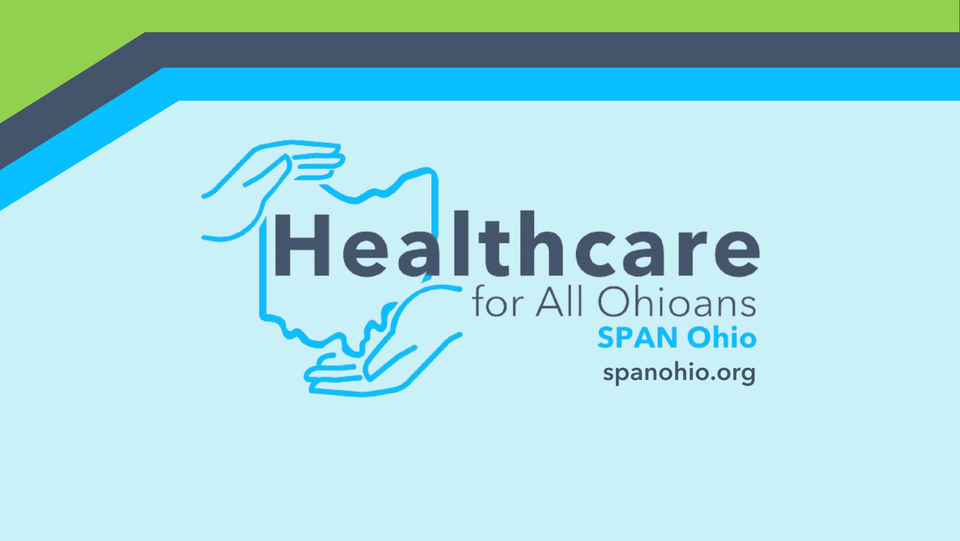
HCFAO/SPAN OHIO LINKS
Healthcare For All Ohioans/SPAN Ohio
To send articles, events, letters, or comments to this newsletter, please email them to the Communications Committee (Linda Brown, Brian Houlehan, Cindy Bamford, Tim Bruce, and Bob Parker (Chair)) The email address is ClevelandSpan@SpanOhio.org. This newsletter is posted under Resources on our website
Follow us on Facebook
Join our Facebook Group here.
Find us on Instagram – healthcare4allohio
We’re now on TikTok! @healthcare4allohio
